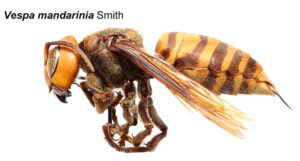Asian Giant Hornet
go.ncsu.edu/readext?689415
en Español / em Português
El inglés es el idioma de control de esta página. En la medida en que haya algún conflicto entre la traducción al inglés y la traducción, el inglés prevalece.
Al hacer clic en el enlace de traducción se activa un servicio de traducción gratuito para convertir la página al español. Al igual que con cualquier traducción por Internet, la conversión no es sensible al contexto y puede que no traduzca el texto en su significado original. NC State Extension no garantiza la exactitud del texto traducido. Por favor, tenga en cuenta que algunas aplicaciones y/o servicios pueden no funcionar como se espera cuando se traducen.
Português
Inglês é o idioma de controle desta página. Na medida que haja algum conflito entre o texto original em Inglês e a tradução, o Inglês prevalece.
Ao clicar no link de tradução, um serviço gratuito de tradução será ativado para converter a página para o Português. Como em qualquer tradução pela internet, a conversão não é sensivel ao contexto e pode não ocorrer a tradução para o significado orginal. O serviço de Extensão da Carolina do Norte (NC State Extension) não garante a exatidão do texto traduzido. Por favor, observe que algumas funções ou serviços podem não funcionar como esperado após a tradução.
English
English is the controlling language of this page. To the extent there is any conflict between the English text and the translation, English controls.
Clicking on the translation link activates a free translation service to convert the page to Spanish. As with any Internet translation, the conversion is not context-sensitive and may not translate the text to its original meaning. NC State Extension does not guarantee the accuracy of the translated text. Please note that some applications and/or services may not function as expected when translated.
Collapse ▲If you have listened to the news lately you may have heard about the invasion of the so-called “Murder Hornet”, the Asian Giant Hornet. It was found on the west coast in Washington State and Canada in 2019. This hornet is NOT in North Carolina.
The queens can be up to 2” long-living up to their name of Asian Giant Hornet. This is another non-native invasive insect that has unintentionally been introduced. The nickname of “murder hornet” is because they can attack and destroy an entire honey bee colony.
We do have two large insects that look very similar to the Asian Giant Hornet, they are just not quite as big and their coloring is slightly different. First is the Cicada Killer wasp which can be up to 1.5” long. This large wasp is solitary, meaning each queen makes her own nest by tunneling in the soil. This wasp stings a cicada and paralyzes it. She then carries it back to her nest, where she lays an egg and places the cicada nearby as food for the larvae when the egg hatches. These wasps can sting but are not aggressive. They are considered beneficial. In the summertime, these are usually the very large wasps that come to outside lights at night.
The second large insect is the Giant European Hornet. This insect will strip bark from thin-barked trees and shrubs such as magnolia, holly, and rhododendron in strips for use in building a paper nest. Finding their nests is often impossible as they don’t build their nest in the plants they damage. If they girdle the stems of plants by chewing strips of bark, the outer portion will die. These hornets can also sting, so if working around shrubs just watch out for them.
For more information about the Asian Giant Hornet and photos with size comparisons to our local wasps and hornets, do an internet search for Dr. Michael Waldvogel and Asian Giant Hornet.





